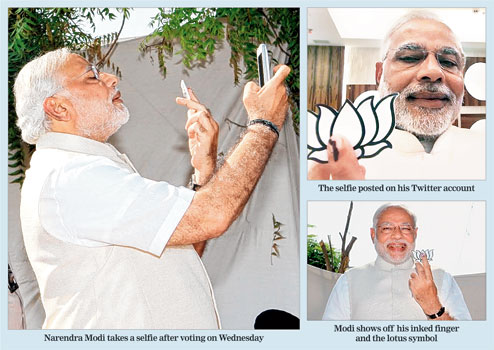India’s First Ever Social Media Election
Narendra Modi captures a selfie giving the world photographic proof that he had placed his vote.
Source: Telegraph India
The selfie was more than just a snapshot of him placing his vote it symbolised the essence of India’s election – as CNN described it, ‘India’s first social media election’.
Inspired by Barack Obama’s 2008 campaign where he was described by the US media as the first social media President, India’s 2014 general elections could well earn the eventual winner the moniker of being the first social media Prime Minister of India.
Candidates have ramped up their efforts in order to woo India’s whopping 200 million internet users, whilst this internet penetration isn’t uniform throughout the country and is only in certain pockets, the power and sphere of influence that it creates should not be underestimated.
Newspapers and radio had once been the predominant way for politicians to get their messages out but the use of new media platforms has lowered the cost of building a political brand, connecting with audiences and engaging with them on a much more personalised way. This has not meant that offline activities have diminished in any shape or form, as the streets of India are filled with images of political logos, candidate’s images and amplified by a juggernaut of merchandising such as ‘the NaMo Store’.
So how exactly are political parties using technology to woo voters?
From bulk texts, voice messaging, micro blogging, LED screens, Google hangouts and even 3D technology, this election is not just about using every piece of technology to get the message out, each parties’ communication strategy is able to breath and walk because of the ‘spine of strategy’ that connects each individual part.
Out of all the parties, BJP’s campaign may very well be the strongest of them all having created a ‘war room’ not only for monitoring Twitter, Facebook and a constant flow of news but to track the smallest of households the BJP has touched, ground challenges, profiles and learning of each voter, resources needed to win in a constituency. The potent aspect of this campaign lies in the notion that each and every approach is mapped with science, data and intense level of analysis proving that it’s not just a superficial campaign but one which has been laced in real-time analysis enabling BJP to target further advertising, raise funds and create models of voter engagement.
In another online campaign, supporters of the Aam Aadmi Party (AAP) were urged to donate a tweet or Facebook status to the newly formed anti-corruption party. Having an official YouTube channel or an active Facebook page is now as important as holding mass rallies and plastering candidates’ faces on billboards.
The social media strategy of the ruling Congress Party doesn’t appear to be as aggressive, both the party president, Sonia Gandhi and her son, Rahul Gandhi, 43, are conspicuous by their absence on Twitter. But their use of WhatsApp for both internal communication and relaying party updates has proved highly effective.
The internet population in India is among the largest in the world, this is not to say that each and every voter has access to these new media platforms as the impact, as of now, remains limited largely to urban areas and well-off sections of society. With the elections in full force only time will tell if strategies employed by each party have been effective or not. One thing is for sure though, the battle of hearts and minds is not only live on the ground but also in cyberspace.

